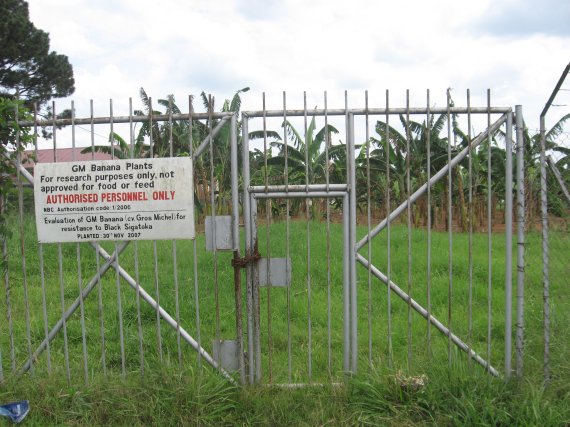A testing field for bananas at the Kawanda Agriculture Research Institute in Uganda. © Justus Wesseler
The delay in use of genetically engineered (GE) crops occurs because government bodies do not make decisions on the policies concerning the sale of the seeds in their country. According to Wesseler, this is comprehensible: ‘The information received by the authorities often is contradictory. Some instances or organisations will tell them that genetically engineered seeds are unsafe for the environment and human health, while others will tell them that it is fully safe to use.’ Due to this contradictory information, the policy makers postpone their decisions.
Human lives
The delay in the use of GE crops can mount up to years. In Kenya, people tried to introduce a genetically engineered maize variety in 2006, but a decision has yet to be made. If they had allowed the crops, it could have saved between 440 and 4,000 lives, according to Wesseler’s calculations. If Uganda had allowed banana crops that are resistant to the banana disease Black Sigatoka in 2007, an estimated 500 to 5,500 lives could have been spared. The government of Nigeria expects to make a decision this year concerning a bean variety that is resistant to a feared moth. Wesseler predicts that a delay of a single year could easily cost as much as 28 million euros and between 100 and 3,000 lives.
I had not expected it to make such a difference.
Justus Wesseler
Wesseler found these numbers by estimating how much bigger a farmer’s harvest could be with GE crops. Besides the revenue in market value, he also calculated how many extra calories that larger harvest would yield. He then compared this to data on undernourishment among children. ‘I had not expected it to make such a difference’, Wesseler admits.
Living conditions
Should countries allow for GE crops en masse? Wesseler thinks this should indeed be the case. ‘It is a great mistake not to use these crops. They yield larger harvests and require fewer pesticides, as they are resistant to specific pests. The use of genetically engineered crops is an available solution that could be used after a failed harvest to prevent undernourishment. Shutting out GE development in agriculture is not wise. If anything goes wrong during a harvest, there are very few options left to provide the population with sufficient food.’
Shutting out GE development in agriculture is not wise.
Justus Wesseler
Wesseler also thinks that importing GE seeds might help prevent the migrant flows. If the economic situation of a family improves because of higher yields due to GE crops, then the chances that these people will migrate to another region on economic grounds will diminish. ‘If your living conditions improve, you stay. If they continue to worsen, you leave. This happened in Europe in the 19th century. Irish farmers left to the United States en masse after the failed potato harvests between 1845 and 1850.’
Additional reading (partly in Dutch):
Cutting and pasting genes
Vertrouwen in voedsel begint niet met meer kennis
Resistente aardappels geplaagd door gmo-opinie

